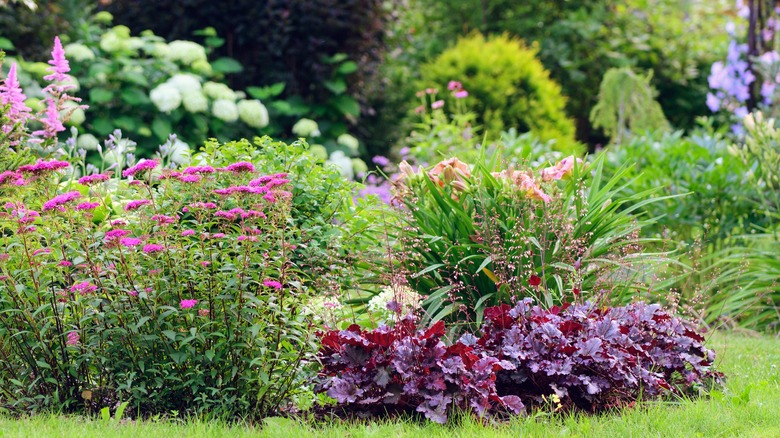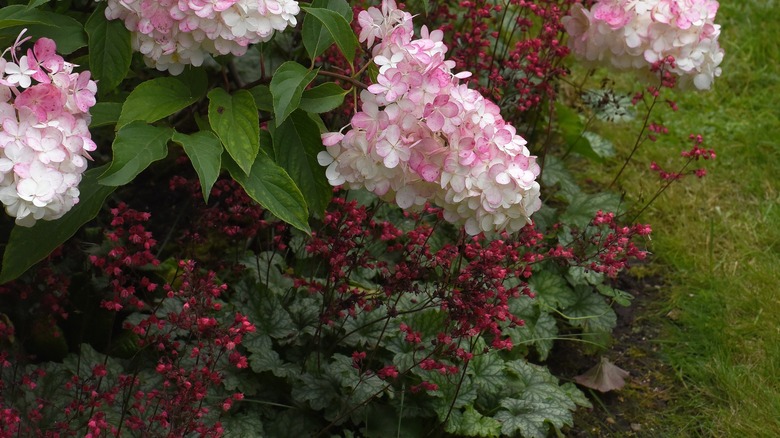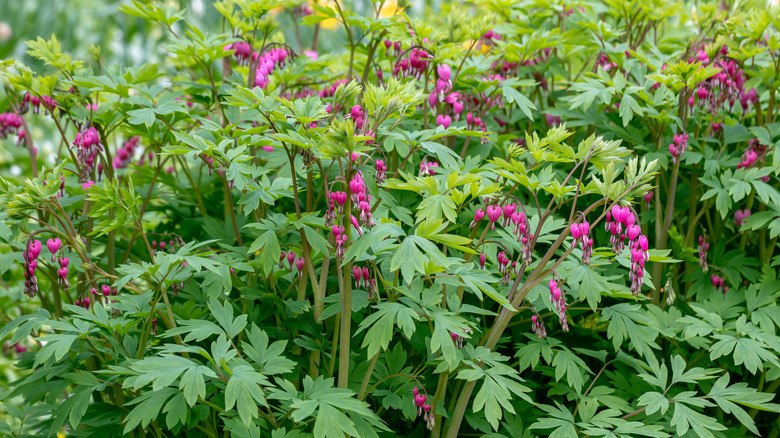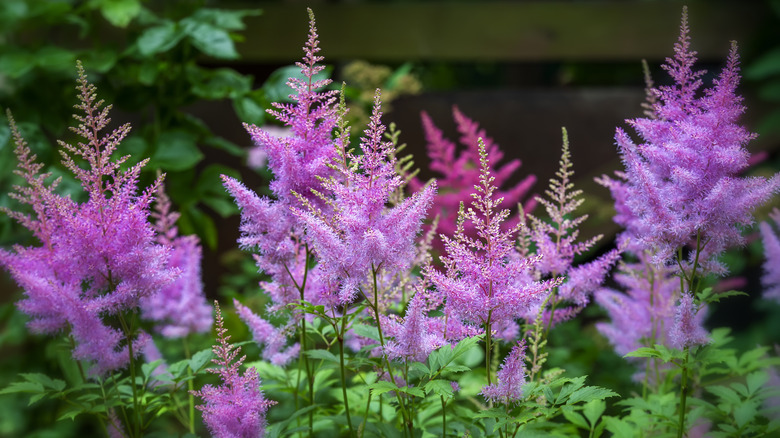3 Beautiful Garden Flowers To Grow Near Colorful Heuchera Plants
Heuchera is an exquisite perennial whose broad, vivid foliage serves as effective ground cover and looks stunning against taller filler species. But alas, you can't just grow heuchera — also known as coral bells — next to any plants you like. Many flowers whose prominent blooms would create a striking accent next to heuchera just aren't suited for coral bells' preferred growing conditions, which include limited sun exposure and plenty of moisture. To design a garden bed that's as healthy and vibrant as it is aesthetically appealing, you need to find plants that can complement your coral bells and cohabit happily next to them.
Three species of garden flowers fit the bill nicely. Hydrangeas, bleeding hearts, and astilbes make an appealing visual composition when planted in a heuchera flower bed while thriving in the same habitat. These plants balance out coral bells' short stature, with taller stems and larger, bolder flowers. Fortunately, these three picks will get along with your coral bells just fine, too, since these plants flourish in the same low-light, moist conditions the coral bells prefer.
Hydrangeas add height to your heuchera flower beds
Hydrangeas are perennial, deciduous shrubs that easily grow over 4 feet tall — a quality that gives your garden some height next to the shorter heucheras. Likewise, their vibrant blooms create an attractive layer of color towering above the coral bells. Apart from mere aesthetics, heuchera and hydrangeas get along well as companion plants. Since the two species thrive in similar climate, soil, and lighting conditions, you should have no trouble growing both in harmony.
Similar to heuchera, hydrangeas are well-adapted to wide-ranging climates. Heuchera is hardy in USDA Zones 3 to 9, whereas hydrangeas prefer only slightly warmer conditions, with a northern limit at Zone 4. Like heuchera, hydrangeas also flourish when exposed to direct sun for a few hours, with partial shade for the rest of the day, so be sure to plant them in a suitable spot. And if you've opted to grow hydrangeas as a companion plant for the coral bells, water them at least weekly. As for soil conditions, hydrangeas will do just fine in the kind of acidic-to-neutral soil in which heucheras thrive. That said, hydrangeas' blooms will change color depending on the soil acidity. When the pH level is below about 5, the flowers will turn blue. Meanwhile, higher alkalinity levels will change the blooms to pink.
Bleeding hearts' intricate blooms complement heuchera's bell-shaped flowers
Heuchera's large, kaleidoscopic leaves steal the spotlight from the plants' tiny flowers. On the other hand, bleeding hearts are mostly grown for their elaborate blooms. The blooms hang from the stem and comprise two sets of petals. One set forms an outer, heart-shaped shell, with a smaller set of two petals protruding from inside it. When you grow coral bells alongside these plants, you get an attractive composition that features colorful foliage courtesy of the heuchera along with bleeding hearts' captivating flowers. Growing the two plants nearby is easy, as they largely have the same preferences for lighting, soil conditions, and climate.
Bleeding hearts are hardy in zones 2 to 8, so you can grow them across much of the contiguous United States, apart from the hottest climates in the south. These herbaceous perennials prefer shade to sun. However, you can safely plant them in a spot that gets full sun in the mornings and transitions to shade in the afternoon, especially if the summer temperatures stay mild and there's plenty of moisture. Conversely, hot and dry summer conditions will cause the bleeding hearts to turn yellow, die back, and eventually become dormant. To help your bleeding hearts thrive, be sure to plant them in well-drained, nutrient-rich soil.
Astilbes add a bold splash of color next to heucheras
Astilbes' flashy blooms inject lively color into your heuchera beds. These perennials are best known for their spike-shaped bloom clumps, which can be red, white, pink, or purple. The blossoms will stay on astilbes' stems for about three weeks during the summer, although bloom times differ with varieties. Astilbes are suitable companions for heuchera, as they, too, like shade and grow in similar soil conditions.
When pairing astilbes with coral bells, consider the height of the plants. Some astilbe varieties can sprout up to 4 feet, while others grow to less than 6 inches in height. A good option is to opt for a taller species and plant them behind the coral bells to create a layered aesthetic. When you plant your astilbes in the garden, choose a shady spot to avoid leaf-scorching in the summer. That said, these plants will tolerate a bit of sun as long as their roots remain moist. Water the astilbes often, and don't let the surrounding substrate dry out — especially in the hot summer months.



